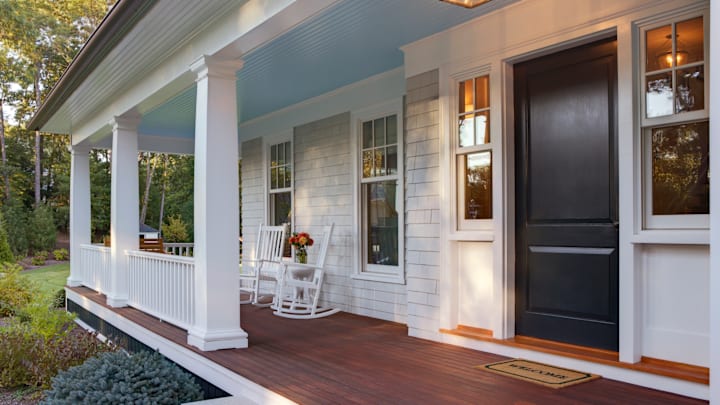Across the South, a unique tradition hangs overhead: sky-blue porch ceilings.
Whether you’ve noticed them subtly softening the light above a historic wraparound veranda or brightening up a cozy cottage stoop, these pale blue-hued ceilings, commonly referred to as haint blue, are more than just a decorative choice—they’re steeped in cultural folklore, practical logic, and, of course, timeless charm.
Below, we'll break down more of the rich history behind this compelling paint color.
- What Is Haint Blue?
- The Folklore History Behind Haint Blue
- Does Painting Your Porch Ceiling Blue Actually Repel Bugs?
What Is Haint Blue?
It's important to note that haint blue isn’t one specific color. Instead, it spans different shades of blue-green, from robin’s egg to powdery sky tones. The ideal shade for your porch depends on factors such as natural light, the color of your trim, and your home’s overall color palette.
Beyond any ties to folklore or pest control, haint blue ceilings are often considered simply beautiful. The soft hue mimics the sky, enhances natural light, and complements a classic Southern porch kind of setting: white trim, wicker furniture, and leafy potted plants.
The Folklore History Behind Haint Blue
The tradition of painting porch ceilings blue can be traced back to the Gullah Geechee people, descendants of enslaved people who lived along the coastal regions of the southeastern United States.
In their cultural folklore, haints, a variation of the word haunts, refers to malevolent spirits known to wreak havoc. However, as the legend goes, these spirits can’t cross water. So, by painting porch ceilings a watery blue, homeowners hoped to confuse the spirits into thinking they’d hit a barrier, thus keeping them away from the home.
As time passed, this superstition gained more mainstream acceptance throughout the region, particularly in Georgia and South Carolina. Even those who didn’t believe in haints kept up the practice—just in case. In the process, the distinctive pale blue color became a defining visual element of Southern architecture and overall aesthetic.
Does Painting Your Porch Ceiling Blue Actually Repel Bugs?
Another longstanding claim is that haint blue ceilings may help to repel insects, notably wasps and mosquitoes. Some believe bugs mistake the blue hue for the sky and avoid nesting on the ceiling altogether.
While the science behind that theory is questionable, there’s some truth to it. Historically, paints were often mixed with lye, a known insect repellent, which could be another possible explanation.
Today, most paints no longer contain any lye; however, the insect-repelling legend persists. In fact, some homeowners still swear by it.
And though few modern homeowners paint their ceilings to ward off spirits, the haint blue tradition carries symbolic weight—a quiet nod to centuries-old cultural heritage and craftsmanship rather than just a decorative flourish. So, next time you’re sitting on the porch sipping sweet tea, take a moment to look up.
Have you got a Big Question you'd like us to answer? If so, let us know by emailing bigquestions@mentalfloss.com.
Read More Big Questions:
